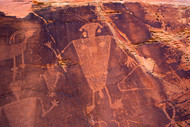Native American Petroglyphs
Aug 6th 2020
 Native American petroglyphs, most commonly found in the Southwest, were both artistic and informative. They convey a rich history that predates written languages and lives on today.
Native American petroglyphs, most commonly found in the Southwest, were both artistic and informative. They convey a rich history that predates written languages and lives on today.
Native American Petroglyphs: What They Are and Where to Find Them
Storytelling is found in cultures spanning centuries and continents. Before written history existed, experiences were shared and passed on through spoken tales and legends. Eventually, humans found more permanent ways to mark travel routes, deliver warnings, and pass on history, and it began with drawing pictures on rocks.
As early as 40,000 years ago, people created cave paintings to express their experiences—an image of a species of wild cattle found in caves in Borneo is now considered the "oldest figurative cave painting in the world." It far predates the famous cave paintings in Lascaux, France, which are estimated at 20,000 years old.
Such artwork can be found across the globe, including in North America, where Native American tribes used petroglyphs, or symbols and images carved into rock, to convey all kinds of messages, from personal experiences to maps used for hunting. Why were petroglyphs so important to Native American cultures? Where can you see these pieces of history today?
The Form and Function of Petroglyphs
Although petroglyphs are not the same as the written languages we use today, they were intended to convey meaning. The type and use of petroglyphs varied from one tribe to the next, but often, symbols had specific definitions or meanings, often with a variety of connotations depending on context. Unlike hieroglyphics, which were used to represent specific words, the meaning of petroglyphs can vary widely depending on usage, placement, and proximity to other symbols.
In some cases, the same symbols were used by many tribes, perhaps as a way to overcome language barriers. Some were used to symbolize individuals, families, or tribes, as a way to show they had been to a certain area—the ancient equivalent of today's ubiquitous public bathroom proclamation "[insert name] was here." These markers may have served as reminders of good hunting areas, or as warnings of danger.
The oldest known Native American petroglyphs, found at Winnemucca Lake outside of Reno, NV, are estimated to be at least 10,500 years old, although they could date as far back as 14,800 years. Frequently, many petroglyphs spanning centuries are found in the same location. These rich tapestries of petroglyphs spanning hundreds of years have created a history that informs us today about the diverse culture, artistry, and lives of Native American tribes.
Viewing Petroglyphs Today
Native American petroglyphs are predominantly found in the Southwestern part of the country, with the largest concentrations to date in Utah, New Mexico, and Texas. Not all sites are open to the public, but there are several where visitors can view and learn more about petroglyphs.
One of the best sites to visit is Petroglyph National Monument in New Mexico. It is estimated that this location features more than 25,000 petroglyphs spread across 17 miles.
What makes this site so interesting is that it features not only images estimated to date from as far back as 2000 BCE, credited to the ancestors of the Pueblo people, but carvings that continue up into the 1700s, with some entries added by early Spanish settlers. In other words, it's a historical record that spans centuries and cultures and continues to educate us about the past to this day.

